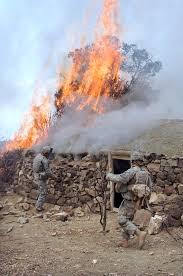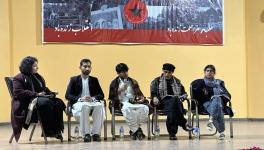Arithmetic of Precision Drone Strikes: Kill 28 to Eliminate 1 Target
The drone strikes have been touted by the US as “precision” weapons, taking out specific “targets” with minimum “collateral damage”, the military speak for killing innocent victims. The recent report in the Guardian (The Guardian, 24 November, 2014)by Reprieve, a human rights group, shows how bogus this claim is – for killing 41 targets, drone strikes killed an estimated 1,147 others. In other words, for successfully killing 1 “target”, 28 people have to be killed.
These figures do not take into account the worst of the drone strikes, the “signature” strikes, where the killing of people is done if interpreted as suspicious behaviour as seen through drone videos. These strikes are not based on specific targets but on the “signature of terrorists”-- a “suspicious” gathering gatherings of people. Obviously, any gathering of people for social purposes or for a local meeting can be considered suspicious by the drone handlers. The New York Times quoted a senior State Department official that when the CIA sees "three guys doing jumping jacks," the agency thinks it is a terrorist training camp.
This account does not take into account who is a target. How much actual intelligence goes into choosing a target, how much is scores created by NSA surveillance tools and how much depends on the President's mood in choosing such kill targets, are all open to question. Obama, as President, has expanded the drone war far beyond what Bush had done.
How many people have died through such drone strikes? Lindsey Graham, a US senator in a public speech (February, 2013) disclosed that 4,700 people have been killed in drone strikes. This closely matches the high end of the figures estimated by London based Bureau of Investigative Journalism that has been tracking the US drone strikes. The current figures exceed 5,100 killed in drone strikes in Pakistan, Yemen and Somalia. The Bureau of Investigative Journalism covers only the covert war, where the formal consent of the governments has not been taken for such strikes. In Afghanistan, drone strikes is not covert as the Afghan government is presumed to be a party to these strikes.
The official US count of non-combatants is at wide variance to other counts. That is when they do acknowledge the drone war. The US assumes all those killed are combatants unless proven otherwise. The US body count, even in Vietnam days, was to count every able-bodied man as a justified target. Only women, children and very old were supposed to be exempt from being targets. With this new method of counting, somebody has to prove that those killed are not men in the “right” age bracket or women. Since the drone strikes take place in remote areas, the US can rest content that there is no “proof” that innocents are dying. If they were, how come they have not come forward and complained?

Image Courtesy: en.wikipedia.org
Drone strikes are not just remote killings, reprehensible as it might be. They are essentially targeted assassinations, where states kill people they consider “dangerous” without any judicial proceedings. In the language of international law, these are extra judicial killings. International human rights law forbids extra judicial killings. So how is the US continuing for the last 10 years to conduct drone strikes and assassinate people? Of course, the US has never bothered about international law when it did not suit its interests – the attack on Libya and openly abetting terrorism in Syria being only the latest examples in a long series of such violations. As a justification for drone strikes, the US maintains it is at “war” and therefore instead of using the normal laws that apply to the conduct of nations, they can use laws of war that permit the killing of combatants. So in the US view, killing of civilians is only collateral damage consequent of action against “enemy” combatants. This is why the “war on terror” is so important for the US. It provides them with the fig leaf that they cannot be held to normal international human rights laws but only to the laws of war. This is also why the US war on terror is an unending one; it is their legal cover for drone strikes.
Christof Heyns, a South African law professor, and the UN's special rapporteur on extra-judicial and summary executions has given yearly reports questioning the legal basis of such strikes. In his latest report, he wrote that there are serious concerns whether such acts conform to International Humanitarian Law (laws of war) or should such strikes be governed by the more general International Human Rights law, not the laws of war. He held further, “To leave such important rules open to interpretation by different sides may lead to the creation of unfavourable precedents where States have wide discretion to take life and there are few prospects of accountability. Such a situation undermines the protection of the right to life. It also undermines the rule of law, and the ability of the international community to maintain a solid foundation for international security”.
The CIA is now urging the White House to significantly expand the agency’s fleet of armed drones to continue this endless “war on terror”. Those who operate the drones, do so with complete impunity, “hiding” in their facilities in Nevada and other such facilities, while thousands of innocent civilians get caught in such strikes. As a notice read at one such drone facility, the pilots were warned that they should be careful while driving back home after a day of war. A traffic accident is the only risk they have in this new form of war, while snuffing out thousands of lives.
The drone war is a step further in making war impersonal and more akin to a video game. The drone console designs are very similar to video game consoles and killing people appear no different than killing animated figures on your screen in a game. The distance from a video game to killing real life people appears a small one, particularly if you are on this side of the console.
What happens to people who are on the other side? A widely reported drone strike was that conducted in the Waziristan border region. On March 17, 2011, four missiles fired from a U.S. drone, hit a bus depot in the town of Datta Khel in Pakistan. It killed 42 persons who were travelling to a jirga (a conclave of village or tribal elders) to settle a local dispute. This was a signature strike – gathering in a place by people is by definition “suspicious”. Any jirga now carries the extra risk of being wiped out as a meeting of possible terrorists. Incidentally, Pakistan authorities had been informed about the jirga but were obviously not in the loop in the execution of such drone strikes.

Image Courtesy: en.wikipedia.org
Such drone strikes against largely civilian population creates conditions that gives rise to more extremism. Instead of eliminating terrorists, such a policy creates many more.
What is even more dangerous for the use of drones as a weapon of war, is that it has ceased to be a high tech device. At the heart of the drone, is electronics that is found in any smart phone – a chip-set that combines the gyroscope, accelerometers, the GPS functions, video cameras, fast processors, etc. All this jingbang lot can be purchased for less than a hundred dollars. The drone body itself can be a small “aircraft” that the aeroplane hobbyists have been using for decades. This is why we are talking of a range of civilian drones, the use of drone for delivering all kinds of goods including pizzas. A fully functional drone, carrying small bombs or a set of books from Amazon, will not cost more than a few thousand dollars.
Countries such as the US have always believed that the weapons that they can build with their high tech war industry cannot be done in the near future by others. Therefore any talk of an international law to ban such weapons is opposed by the US. In the case of drones, the US including its current president, is in love with them, as it avoids the costly problem of having boots on the ground. It is not only costly in terms of money – it costs an enormous amount to keep one US soldier in a war zone and give him McDonald burgers – but also in terms of political costs of returning body bags. The drone wars are nice sanitized wars in which some “gooks” in remote places die but not “real” people. And it also has a nice macho feel to it, “no one can hide from us, we will get you wherever you go”.
The problem is that as civilian drone technology expands, the drone as a weapon of terror will come home to roost as well. More the US attacks other countries, the more they are likely create new extremist groups. Iraq, Syria and Libya had secular states with excellent social infrastructure – public health and education – considering that they were developing countries. Just a few years of war and mayhem – either through direct invasion, as in Iraq and Libya, or through covert war, as in Syria, we now have failed states, broken societies and the rise of sectarian armies. The drone wars is only widening the catchment area for breeding new recruits for these sectarian wars.
The international human rights groups – with a few honourable exceptions – have been loth to take up such blatant violation of human rights. Even when they have done so, their voice has been relatively muted. For these groups, it is easier to go against some tinpot dictator in Africa than confront the most powerful country in the world. That way, the funds from the US Endowment for Democracy, other western governments are all available. So are George Soros funds for coloured revolutions targeting East European and Central Asian nations.
The drone war is only one of the new instruments of war that are being created. In the wings are the autonomous weapons that are now being developed. Here, even the minimal human agency – a human being in a remote location deciding on such a strike – is sought to be removed. Instead, an algorithm will decide who is a target, what activity is suspicious and “decide” to eliminate the target or targets. An even more sanitised war for those conducting it in which you do not even have the moral guilt of taking decisions to kill people.
Humanity is at crossroads. It can either decide that such weapons – drones and autonomous killing machines – are weapons that we should ban much in the same way as we banned chemical and biological weapons earlier. Or we will introduce a new face of war that will have consequences for all of us: enlarging existing wars and sowing seeds of even more destruction.
Disclaimer: The views expressed here are the author's personal views, and do not necessarily represent the views of Newsclick
Get the latest reports & analysis with people's perspective on Protests, movements & deep analytical videos, discussions of the current affairs in your Telegram app. Subscribe to NewsClick's Telegram channel & get Real-Time updates on stories, as they get published on our website.
























